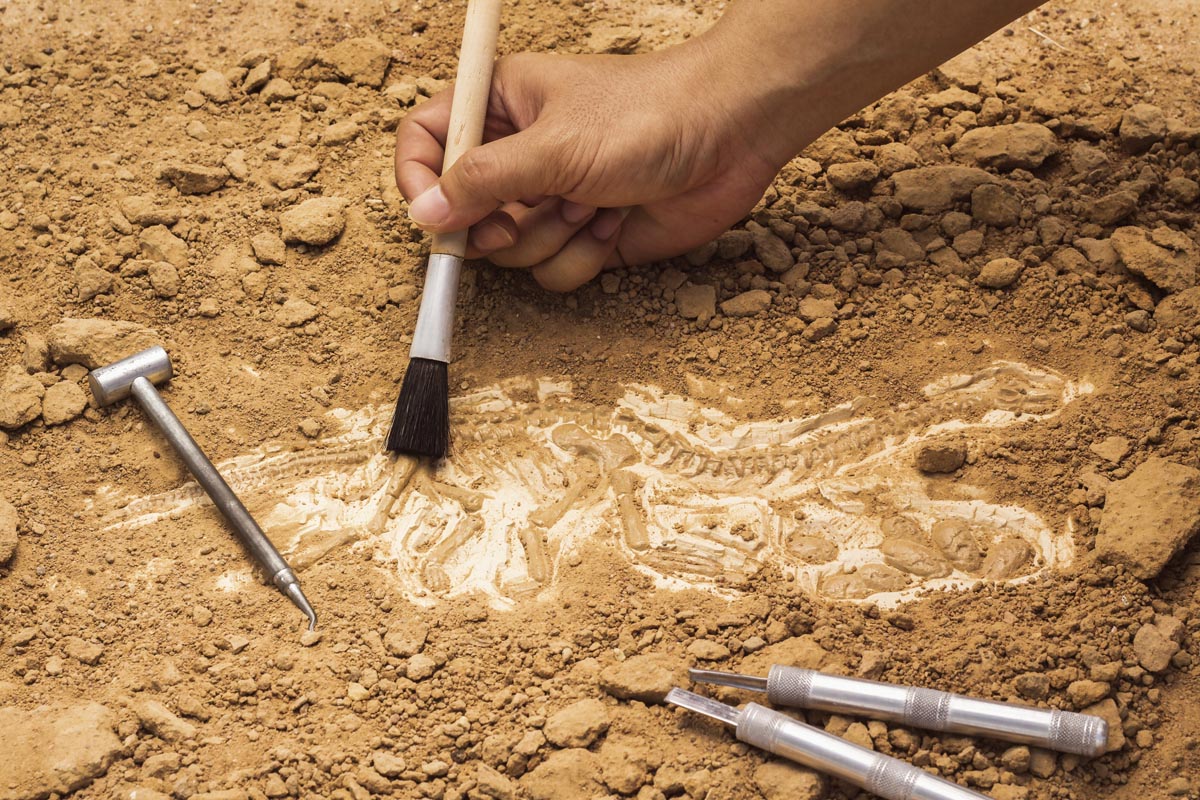by Leonard Brand
Is creation a theory? That could be a trick question because the word theory can have more than one meaning. If we say evolution is a theory, some evolutionary scientists may get upset and respond that evolution is not just a theory; it is a fact. The claim that something is “just a theory” is not really a proper use of the word, but at times, it is used that way, implying that an idea is not important or not true. That is not how I will be using the word theory in this article.
As the word is used in science, a theory is a group of ideas that describes how we think some process works. A theory probably doesn’t answer all our questions, but it is valuable as a guide for research. We don’t understand everything about gravity, but the gravitation theory was used to predict how much power is needed to send a spaceship to the moon and back, and astronauts had enough confidence in the theory to get in the spaceship! Likewise, germ theory suggests experiments to be done and helps us plan new research and discover better ways to prevent disease. A trustworthy theory could save your life.
Modern science got a start in several different countries but made its strongest progress in Christian countries because scientists who are Christians can be confident that everything was made by a very wise and reliable Creator. We can know that nature is guided by God’s laws, and we can trust that His laws will always work the same way.
In the Bible, God told us about creation, the global Flood, and approximately how long ago those events happened. It’s appropriate to call all of this information a theory of creation. It’s not “just a theory.” We have plenty of reason for our confidence that this theory is true, but God didn’t tell us everything we would like to know. He gave us enough information that we can trust what the Bible says, and we can use this theory to do research and learn more. He wants us to think and learn, so He didn’t give us all the details.
Creation theory applied
The Bible doesn’t even have words that scientists use to describe Earth and its history, like Paleozoic, plate tectonics, or mutation. We don’t need to know about those things to know that God loves us. That is most important, but some of us who have a lot of interest in the history of our planet have found that believing what the Bible tells us about creation week and the global Flood catastrophe is also the best preparation for researching and learning about geological history.
The theory of creation reminds us that the rocks and fossils did not form slowly over millions of years but are the result of a catastrophic flood that quickly covered the earth, depositing sediment (mud, sand, or coarser material) to form layers of rocks and bury the animals and plants to become fossils. A lot of evidence tells us that those unfortunate plants and animals could become fossils only if buried very rapidly. Millions of years won’t do it! If they had not been buried rapidly, they would have rotted and disappeared instead of becoming beautiful fossils.
My scientist colleagues and I have spent years doing research on rock formations and fossils. We begin by finding something intriguing that we wish to understand. Then, like any other scientist, the theories that we believe will guide our thinking as we do research. Many scientists believe the theory that requires many millions of years for evolution and the formation of rocks. That is how they always interpret the evidence. When we study the same things, the theory of creation leads us to ask different questions. We don’t ask, “How many millions of years did this take?” We ask, for example, how long did this take? Did it take a long time, or did it happen rapidly? Since we ask different questions, we often see things that others do not notice.1 One fascinating example was research on numerous fossil whales in Peru. Many of the whales are buried in diatomaceous sediment (sediment consisting mostly of microscopic diatom skeletons).
In the ocean today, this type of sediment accumulates a few inches thick in a thousand years. That is the way everyone had explained the Peruvian whales—buried a few inches deeper every thousand years. So, it would take at least 10,000 years to completely bury a large whale! However, dead whales in the ocean today are destroyed by scavengers and decay in a few years, yet the hundreds of fossil whale skeletons are completely articulated and well preserved. Ten thousand years? The conflict between the well-preserved skeletons and those long time periods struck us as impossible. Why had others not thought of that? They were too much influenced by their theory that all these geological processes take millions of years.
We noticed the problem (the accepted explanation does not fit the evidence) because the Bible’s theory of creation opened our thinking to other possibilities. Consequently, our insights and questions resulted in better explanations of the evidence. This field of study is called taphonomy—the study of how organisms become fossils and why. We spent several years collecting evidence revealing how well preserved the whales were and why this required rapid burial. We then submitted a paper on this research to an excellent research journal, and our careful research convinced them to publish it.2 Some other paleontologists did not like our conclusions. They want this all to take very long periods, so that is what they concluded, even though the evidence supports our conclusions, not theirs.
Evidence in the sandstone
Through four decades of research, the same type of biblical insights from using the theory of creation to guide our thinking has resulted in several other research projects. I will mention one more of those projects. Spread across Arizona, USA, is a rock formation called the Coconino Sandstone with sloping layers of cemented sand called cross-bedded sandstone. This type of sandstone can form either in a desert or under water. Geologists had reached the firm conclusion that the Coconino Sandstone accumulated in a desert as wind-blown sand, called an eolian deposit. This desert explanation fits well with their theory that all the rock formations formed slowly over very long time periods. I have heard geologists say that these cross-bedded sandstones, accumulated in deserts, are the biggest embarrassment to flood geologists. Is that really true?
The only fossils in this sandstone are fossilized trackways, mostly of small vertebrates—either lizards or amphibians. The desert origin of these tracks did not look convincing to me, so I began an extended study of the trackways.
This research required much time studying the fossil trackways in Arizona and also experiments in the lab to determine what tracks of living vertebrates would look like when made on sloping sand like the Arizona sandstone, either on dry sand or under water. The fossil tracks in the sandstone are quite clear, with such details as toe marks preserved. However, on dry sand slopes, the sand would slump downhill and cover the details in the tracks. The experimental tracks that compared well with the fossil tracks were salamander tracks made under water. This evidence favored an underwater origin of the tracks.
Some trackways showed an unusual feature. All their toes pointed in one direction, up the slope, but the trackway was moving across the slope, as in the photograph above. It looked as if the animal was walking sideways. Vertebrate animals don’t walk sideways, so how can these be explained? My creation theory suggested an explanation. The animals were under water, and at times, a gentle sideways water current moved them sideways, resulting in what looked like a sideways trackway. If this happened on desert sand, a wind strong enough to move the animal would destroy any tracks.
More laboratory experiments supported this explanation. Other types of evidence also support the underwater origin of the Coconino Sandstone and the fossilized tracks. I prepared a paper proposing the underwater explanation for this evidence, and the paper was published.3Since then, other paleontologists have attempted to give other interpretations of the sideways tracks, but without much success. The eolian desert interpretation of the Coconino Sandstone has hardened in the minds of many geologists, even though almost no one does serious research on the Coconino Sandstone. The desert interpretation fits well in their geological theories, but the creation theory helped us to find better explanations for the evidence.
In summary, although there are serious handicaps in any study of ancient history, such as geological history, because we cannot go back there and see for ourselves what happened, the biblical creation theory offers better explanations for the evidence we find. If we begin with the creation theory that comes from the Bible, it offers valuable insights that help us find sound explanations consistent with the evidence in the rocks and fossils. This is true far beyond the brief examples discussed here.
If you are interested in further study of the evidence for a creation model, consider these resources: Genesis and Science: Where Is the Evidence Going? by Leonard Brand, available at AdventistBookCenter.com. Also, “A Summary of the State of the Evidence Regarding Evolution and Geological History” by Leonard Brand and A. V. Chadwick in Faith, Reason, and Earth History: A Paradigm of Earth and Biological Origins by Intelligent Design, 3rd edition, is available from Andrews University Press, Berrien Springs, Michigan.
Leonard Brand is a former department chair and professor of biology and paleontology in the Department of Earth and Biological Sciences at Loma Linda University. He has published more than 40 scientific research papers and authored six books.
1 Leonard Brand, Speak to the Earth and It Will Teach You: Finding Common Ground Between Faith and Science(Berrien Springs, MI: Andrews University Press, forthcoming).
2 Leonard Brand, Raul Esperante, Art Chadwick, Orlando Poma Porras, and Merling Alomia, “Fossil Whale Preservation Implies High Diatom Accumulation Rate in the Miocene-Pliocene Pisco Formation of Peru,” Geology32, no. 2 (February 2004): 165–168.
3 Leonard Brand, “Field and Laboratory Studies on the Coconino Sandstone (Permian) Vertebrate Footprints and Their Paleoecological Implications,”Palaeogeography, Palaeoclimatology, Palaeoecology 28 (1979): 25–38; Leonard Brand and Thu Tang, “Fossil Vertebrate Footprints in the Coconino Sandstone [Permian] of Northern Arizona: Evidence for Underwater Origin,” Geology 19, no. 12 (1991): 1201–1204.





































